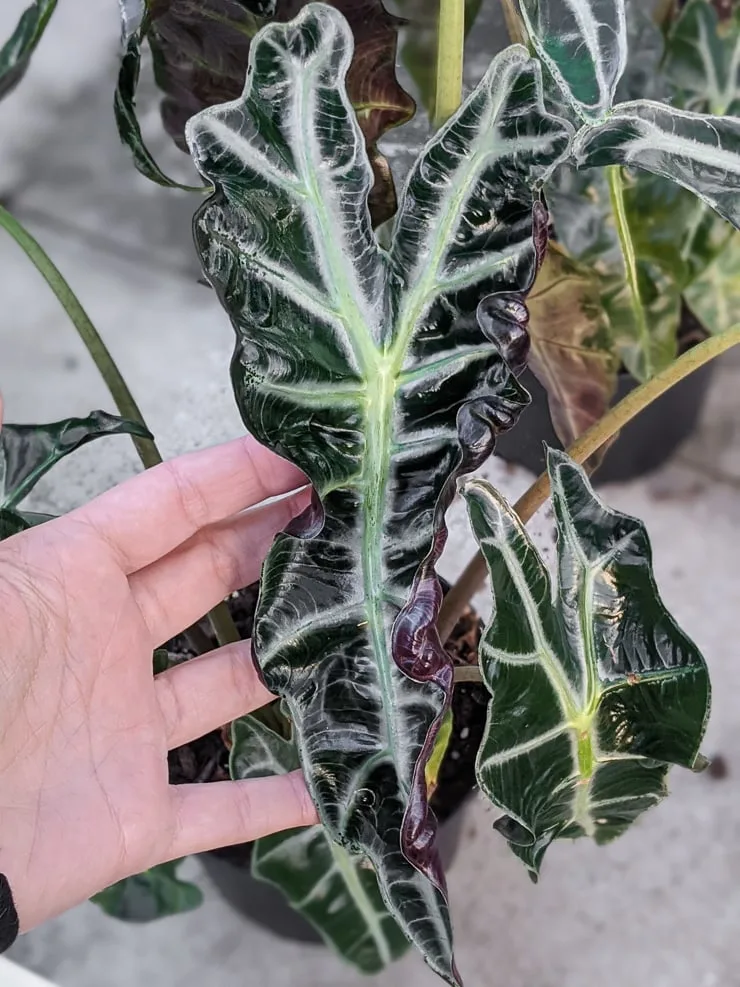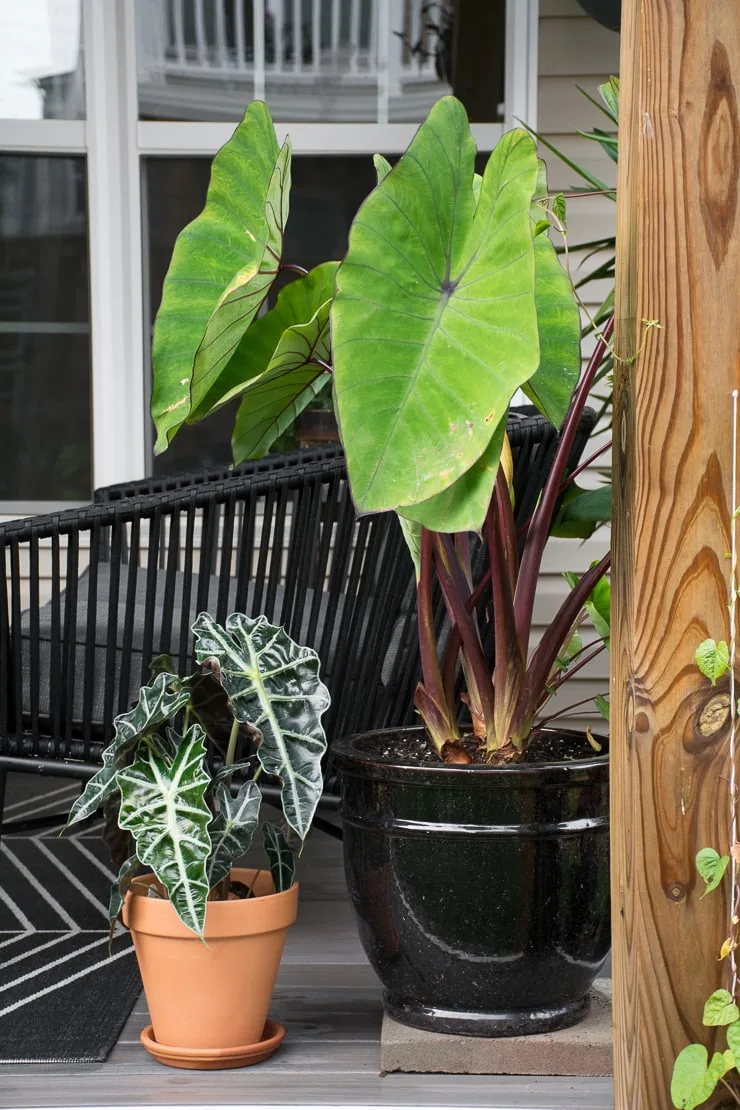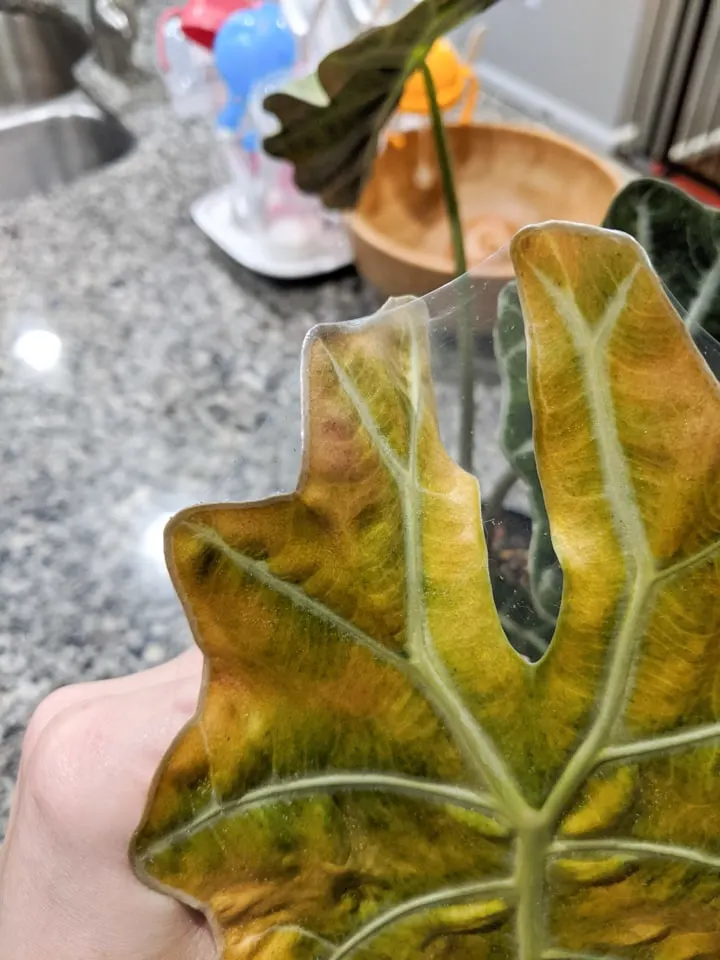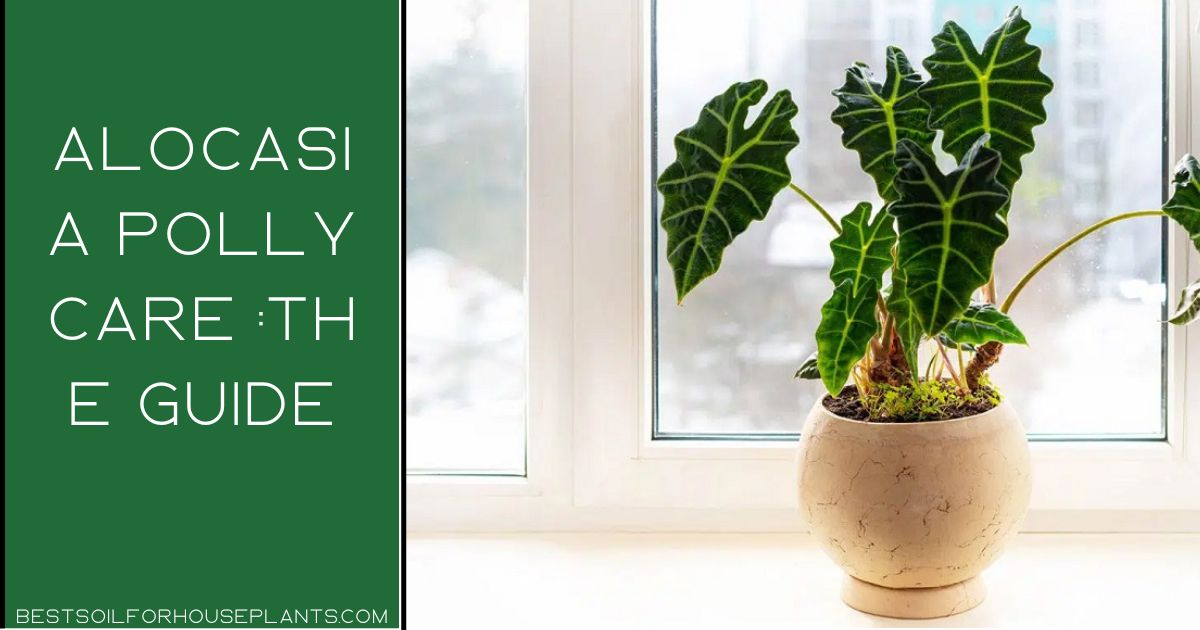Taking care of alocasia polly care houseplants is a useful and enjoyable activity. To ensure your alocasia polly plant continues to remain healthy and vibrant, it must be grown in bright light and kept moist consistently. Alocasia polly typically require water every 1-2 weeks; carefully feel the soil for moisture before deciding whether the alocasia needs to be watered or not. Additionally, alocasias are more tolerant of temperatures between 60°F-85°F, but should not stay in temperatures under 50°F at any time. If possible, keep alocasias away from drafty areas and provide plenty of bright indirect sunlight; if needed, add humidity by misting your alocasia with a spray bottle every few days. With proper alocasia polly care, you will surely value the unique beauty these delightful plants bring.
What does an alocasia polly look like?
The alocasia polly is a stunning sight to behold! With its lush, green foliage boasting bright white veining in thick and wavy leaves measuring up to an impressive one-and-a-half foot long, the plant can be quite majestic with stems sprouting from tuberous rhizomes beneath. It stands tall at around 24 inches and spreads out about as wide; some of the leaves have even been known for their distinct arrowhead shape – making this rare beauty truly something special.
Alocasia Polly Origin and History
Alocasia plants are a mysterious and vibrant species, treasured by botanists around the world. Hailing from tropical Southeast Asia and Australia, there is an array of known varieties – 97 official kinds to be exact! Not content with what nature provided though, many nurseries have taken it upon themselves to develop unique hybrid strains like Alocasia Polly. Although its origin remains unknown due to “Alocasia x amazonica” not being an officially recognized classification; evidence suggests that this scientific name was more likely just invented out of thin air by excited growers eager for something new in their collections.
Alocasia Polly, known by its many common names such as African Mask Plant and Amazonian Elephant Ear, is an enthralling houseplant whose mysterious origin story only increases its allure. This plant stands out thanks to the large impressive leaves which can grow up to 16 inches long and 10 inches wide; they are thick leathery dark green in color with striking bright white or silver veining that contrast wonderfully against their edges outlined in cream or light green for further depth of character. On average Alocasia Polly grows 2 feet tall on top of a central rhizome from where magnificent foliage emerges ready to transform any living space
Alocasia bambino vs. polly
If you’re looking for a petite version of the classic alocasia polly/amazonica, then look no further than an alocasia bambino! This compact little plant has all the same features as its big brother; however, it does not grow above one foot in height and boasts smaller leaves with less dramatic rippling.
Alocasia African mask vs. polly
If you’re searching for an exotic-looking houseplant, look no further than the Alocasia Polly! This dramatic foliage has been given many labels over time – but recently “African Mask Plant” seems to be losing its popularity. Be sure to check your local nurseries for this rare gem of a plant; it’s sure to add a mysterious and wondrous touch to any room in your home.

How much light does alocasia polly need?
Alocasia polly plants love bright and indirect light – they’re not fans of the extreme! To ensure their optimal health, providing them with medium to low levels of lighting is key. But don’t write off direct light just yet- I’ve seen one thrive under those conditions when exposed to it gradually over time as the season progressed. And let me tell you: my Alocasia Polly was quite content in the peak sun for an extended period throughout most afternoons until evenings.

Alocasia Polly Care
Alocasia Polly is an eye-catching tropical plant that requires special attention in order to thrive. With the proper lighting, watering schedules, and temperature levels you can ensure a healthy Alocasia Polly all year round! Not only will it bring life into your home or garden but with regular potting and fertilizing this beautiful species of plant can really show off its potential.
Lighting
The Alocasia Polly needs plenty of sun – just not too much. Too intense or direct sunlight will lead to burned foliage and a parched plant, so heed the advice: give your little friend an airy spot at least one foot away from the window, ideally facing south. If you see yellow leaves beginning to crop up, this could be a sign that it’s getting too hot for comfort! Filter out any rays with thin curtains if necessary and keep your eye on those delicate new fronds – they are particularly sensitive even when indirect light is shining through them.
Watering
Alocasias possess a remarkable superpower – their tall stems store water, which makes them able to self-feed! However, this means the home grower needs to be extra mindful when watering. Letting the top inch of soil dry before each irrigation will guard against overwatering and potential root rot. With simple attention and care your Alocasia can thrive in its new tropical oasis right inside your own house.
If your Alocasia’s stalks are drooping more than usual, this is a sure sign it needs some TLC. When watering the plant, make sure to slowly add enough until all of its holes have been filled and emptied any excess water from under the pot. Be careful if using tap water – chlorine in most city supplies isn’t ideal for these sensitive plants so opt for filtered fluids instead.
Temperature & Humidity
To ensure your Alocasia thrives, you need to provide a humid tropical environment. Aim for household temperatures between 60-80F and humidity at least above 60%. If the air in your home is too dry for these conditions, consider investing in a humidifier or setting up an easy DIY pebble tray to help maintain maximum moisture levels.
Bring a fresh, natural look and feel to the room while boosting humidity levels with this easy trick! Start by filling an empty tray with small pebbles, then carefully place your Alocasia plant on top. Gently fill the tray up to just below its roots or soil – too much water could be damaging for it. As time passes you’ll start noticing that soothing steamy environment in no-time: all thanks to evaporation making sure your beloved houseplant won’t suffer from drafts due air conditioners and radiators’ temperature changes.
Soil & Pots
The Alocasia Polly, with its remarkable ability to store water within itself, doesn’t require overly moist soil. To ensure your plant remains Healthy and content however an Aroid potting mix that is well draining should be used – adding perlite will enhance this further! An equally viable option for growing this species is Leca — clay balls which help maintain a balanced level of hydration without providing nourishment; additional feeding would then need to be provided.
When it comes to Alocasias, drainage is key—choose a pot with holes in the bottom for optimal water control. Clay and terracotta pots should be avoided at all costs since they may sap moisture from soil too quickly leading to an unhappy plant.
Fertilizer
Polly is a burgeoning beauty that requires plenty of nourishment to thrive. To maintain her vigor throughout the growing season (spring through early fall), treat her to a soothing houseplant fertilizer once every month; rest and relaxation should be the focus come wintertime.
Pruning
To keep your plants looking lush and vibrant, it’s important to prune away any dead or dying leaves. Doing so ensures the health of each plant and helps them stay in top condition.
Repotting
Polly loves the snugness of her pot, so you won’t need to worry about repotting too often. If you want your plant buddy to stay at a steady size, just keep it in its same container – but don’t go overboard if sizing up; this puts Polly at risk for overwatering.
Toxicity
The Alocasia Polly plant may be beautiful, but it is a danger to both people and animals if ingested. It’s important to keep this toxic species away from children and pets for safety.
Alocasia Polly Propagation
Propagating an Alocasia Polly is surprisingly straightforward. By collecting the bulbs, which are located beneath the soil around parent roots or can even fall off when being removed from its pot, you will be able to successfully grow new plants right in your own home! Although small and sometimes tricky to find at first glance, with patience they can easily become a piece of art that beautifies any interior space – without delay.
Repotting Alocasia Polly is the perfect opportunity to check for new bulbs. Plant these in moist soil, then let nature do its work – but don’t forget about patience! Too much water can cause rot and roots may take a few months before emerging into little white tendrils followed by stems; an exciting sign your waiting period has paid off.
Issues you might encounter
As you embrace your alocasia polly care journey, be sure to keep an eye out for potential problems that could threaten the health of your plant. Watch carefully and act fast when symptoms arise – they can spell danger if ignored! Monitor things like discoloration or wilting foliage, reduced growth rate or soft stems; all signs pointing towards a larger problem.
1. Alocasia polly developing brown spots or stems drooping
Caring for an Alocasia polly can be tricky, but understanding how to prevent, and even treat, root rot is essential in keeping your plant alive and healthy. Brown spots that appear on the vivid foliage of your Alocasia polly can be caused by overwatering and/or improper potting soil. If the brown spots are soft and mushy in texture, chances are you are dealing with root rot. It’s imperative to act quickly because the infection will spread until it kills off the entire leaf. By reducing watering or changing the potting soil you can either prevent root rot or stop it before it has a chance to take full effect – so don’t hesitate to give your alocasia polly some extra TLC.
I recently decided I had to try and take home the alocasia polly I spotted on the clearance shelf at Walmart – I’m a sucker, what can I say. When I arrived home with it, all seemed normal but when I took it out of the potting soil and saw how mushy the roots were, it quickly became apparent something was not right. It turned out to be a good lesson in alocasia polly care – root rot had set in due to overwatering and there was nothing I could do save for re-potting and hoping for the best. Unfortunately, the brown spots were slowly spreading across the leaves so it soon became obvious that this was a fungal issue as well. Even if my attempt to rescue this plant wasn’t successful, it was still an educational experience.

2. Yellowing alocasia polly leaves & droopy stems
Even with the best of care, Alocasia Polly plants can sometimes succumb to a few yellowing and drooping leaves. Although it’s natural for this species to shed some foliage as part of its growth cycle, too much discoloration could be due excessive watering or dense soil conditions. Trimming away any affected areas will help your plant maintain its vibrancy – just keep an eye on those overwatering tendencies.
3. Yellowing or browning leaves accompanied by fine webbing
If your alocasia polly is showing signs of yellow discoloration and webbing, it’s likely been infested with spider mites. Unfortunately, the leaves that have already changed color cannot be saved, but you can take action to save the remainder of the plant! It may feel like a daunting task if this has never happened before – after all, who hasn’t had their own run-in with those pint-sized pests? But rest assured: my first polly suffered greatly from spiders as well!
At one point I noticed dead browning foliage and another leaf covered in yellow spots. Don’t let these little buggers ruin your beautiful flowers any longer; fight back against them today so you can enjoy vibrant petals for years to come.

When I spotted it, at first glance the discoloration of my plant’s leaves seemed innocent enough – but upon a closer look there were unmistakable signs of an enemy: spider mites. These microscopic invaders had spun their webs around each leaf and stem, content in knowing that they could soon drain life from the hapless victim if not taken care of quickly. Thankfully though, storebought insecticide sprays can still treat these pests so all hope is not lost yet.
After a ruthless infestation of spider mites, my poor alocasia polly was beyond help. I had to ruthlessly trim it down just above the soil line and treat what remained with insecticide. With any luck, come springtime there will be fresh new sprouts- fingers crossed! The reason why indoor plants like these are so prone to their unwelcome guests is that spiders simply love warm dry environments—essentially this winter home sweet home for them.
To keep spider mites from infesting your alocasia plants, regular misting with cool water can help. I haven’t had much success in keeping them away, but the only alocasia that’s ever come through a winter unscathed was when it was tightly wrapped in plastic to contain its humidity levels.





4. Alocasia polly leaves curling up
With all the issues a struggling plant-parent can face, it was only natural for my beloved alocasia polly to start showing signs of distress in its curling leaves. The culprit? Too much direct sunlight or not enough humidity! A bit of experimentation revealed that by adjusting either one variable at a time I could reduce these symptoms and give this sweetheart some relief.
Is alocasia polly safe for pets?
While alocasia polly is an attractive fixture in any garden, it should be kept away from pets and small children who might have a tendency to sample some of its foliage. The plant contains calcium oxalate crystals that can cause severe gastrointestinal irritation if ingested – not exactly the way anyone wants to spend their day!
Why do my Polly Alocasia leaves have brown edges?
The bright sunshine can give your plant a sunburn! If you want to keep it looking healthy, make sure you move it away from direct light so that its leaf edges don’t become dried out and scorched.
What happens during winter dormancy with my Alocasia Polly?
Alocasia Polly deserves a break! During the winter season, this plant requires much less water and no fertilization to rest. If your Alocasia drops its leaves or even goes completely bare, don’t be alarmed; it’s just part of their lifecycle preparing for new growth in springtime when stems will bloom anew.
What are the leaves on my Alocasia Polly turning yellow and falling off?
Leaves are like our own protective forces – once they’re too old and faded, it’s time to let them go. Alocasia Polly utilizes this natural process with precision: as soon as the plant has reached its capacity of 5-8 leaves, any new adventurous ones must bid farewell in order for more vigorous ones to take their place. A majestic reminder that sometimes we need a bit of pruning before blossoming further!
What are there little drops of water on my Alocasia Polly leaves?
Alocasias have a unique way of communicating when they’ve had too much water – literally! If you see little drops of sweat on the leaves, it’s time to re-evaluate your watering schedule and take a breather. Make sure only an inch or so at the top is dry before giving them some H2O love again– doing this will ensure your plant stays perfectly hydrated without running into any serious problems like overwatering.
Is Alocasia Polly rare?
Alocasia Polly’s unique and captivating beauty is a rare treat! Its lush, dark green leaves with impressive white veining make it an attractive addition to any home. But don’t be fooled by its delicate exterior—with the right care routine this plant can live for years. Don’t miss out on your chance if you come across one – they’re hard to find and availability varies widely so stock up while you have the opportunity.
Read more: Overwatered string of hearts

